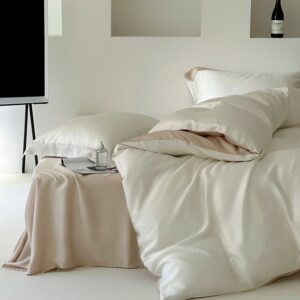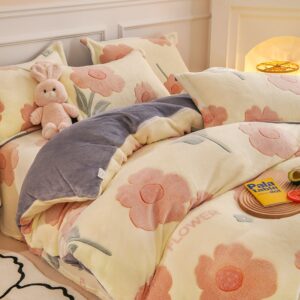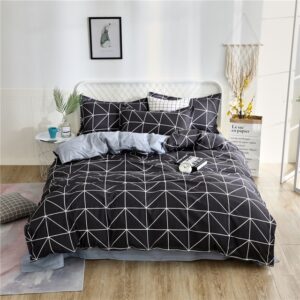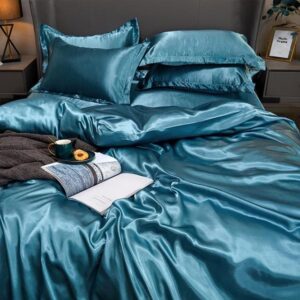The Ultimate Guide to Choosing the Perfect Duvet Cover/Quilt
Enhance Your Bedroom Décor and Sleep Comfortably

Are you tired of tossing and turning at night, unable to find the perfect level of comfort? Look no further than the ultimate guide to choosing the perfect duvet cover/quilt. Not only will you enhance your bedroom décor, but you’ll also enjoy a blissful night’s sleep.
When it comes to selecting the ideal duvet cover/quilt, there are several factors to consider. From the fabric and thread count to the design and colour, each element plays a crucial role in creating the ideal sleeping environment. Whether you prefer a luxurious silk duvet cover/quilt or a cosy cotton one, there is something for everyone.
In this comprehensive guide, we will take you through the essential aspects of choosing the perfect duvet cover/quilt. We will explore different materials and their benefits, provide tips on selecting the right size and style, and even delve into the world of seasonal duvet cover quilts.
Say goodbye to restless nights and hello to the perfect night’s sleep. Let’s transform your bedroom décor and experience unparalleled comfort with the ultimate duvet cover/quilt guide.
Types of Duvet/Covers – Cotton, Linen, Silk, Microfiber, etc.
Duvet covers are an essential part of any bedding set. They protect the duvet from dirt, dust, and stains, and also add style and comfort to your bedroom. There are many types of duvet covers available in the market, each with its own advantages and disadvantages. Here are some of the most common types of duvet covers and their features:
- Cotton: Cotton is a natural fabric that is breathable, durable, and easy to care for. Cotton duvet covers are soft, smooth, and comfortable, and they come in a variety of colours, patterns, and thread counts. Cotton duvet covers are suitable for all seasons and can be washed in a machine.
- Linen: Linen is another natural fabric that is made from flax fibres. Linen duvet covers are lightweight, airy, and absorbent, and they have a rustic and casual look. Linen duvet covers are ideal for summer and warm climates, as they keep you cool and dry. Linen duvet covers can be machine washed, but they may wrinkle easily.
- Silk: Silk is a luxurious fabric that is made from the cocoons of silkworms. Silk duvet covers are soft, smooth, and shiny, and they have a high-end and elegant appearance. Silk duvet covers are good for your skin and hair, as they prevent friction and moisture loss. Silk duvet covers are also hypoallergenic and resistant to dust mites. However, silk duvet covers are expensive, delicate, and require special care. They should be hand washed or dry cleaned only.
- Microfiber: Microfiber is a synthetic fabric that is made from very fine fibres of polyester or nylon. Microfiber duvet covers are soft, cosy, and warm, and they have a velvety or suede-like texture. Microfiber duvet covers are also stain-resistant, wrinkle-resistant, and easy to wash. Microfiber duvet covers are great for winter and cold climates, as they retain heat well.
Factors to consider when choosing a duvet cover – size, material, thread count, durability, and design
Understanding Different Closure Types – Buttons, Zippers, Ties, and Snaps

When choosing a garment, one of the factors to consider is the type of closure it has. Different closure types have different advantages and disadvantages, depending on the style, function, and comfort of the garment. In this article, we will compare four common closure types: buttons, zippers, ties, and snaps.
Buttons are one of the oldest and most versatile closure types. They can be made from various materials, such as metal, plastic, wood, or shell. They can also come in different shapes, sizes, and colours, to match the design of the garment. Buttons are usually attached to a buttonhole on one side of the fabric, and a loop or shank on the other side. Buttons can be used to create a fitted or loose look, depending on how many are fastened or unfastened. However, buttons can also be difficult to fasten or unfasten, especially for people with limited dexterity or vision. Buttons can also fall off or break easily, requiring sewing or replacement.
Zippers are another popular closure type that consists of two rows of interlocking teeth that can be pulled together or apart by a slider. Zippers can be made from metal or plastic, and can have different finishes, such as gold, silver, or brass. Zippers can also be hidden or exposed, depending on the aesthetic preference of the garment. Zippers are usually faster and easier to use than buttons, as they only require one hand to operate. Zippers can also create a smooth and seamless look, as they do not create gaps or bulges in the fabric. However, zippers can also get stuck or jammed, especially if the fabric gets caught in the teeth. Zippers can also break or separate, requiring repair or replacement.
Ties are another closure type that consists of long strips of fabric that can be tied together in various ways, such as bows, knots, or loops. Ties can be made from the same fabric as the garment, or from a contrasting fabric for a decorative effect. Ties can also be placed in different locations on the garment, such as the front, back, side, or waist. Ties can be used to create a customized fit and shape for the wearer, as they can be adjusted to suit different body types and preferences. Ties can also add a touch of elegance and femininity to the garment, as they create soft and flowing lines. However, ties can also be inconvenient and time-consuming to use, as they require both hands and some skill to tie properly. Ties can also come undone easily, causing the garment to open or fall off.
Snaps are another closure type that consists of two round pieces of metal or plastic that snap together when pressed. Snaps can be attached to the fabric by sewing or adhesive, and can have different colours and sizes to match the garment. Snaps are usually simple and quick to use, as they only require a gentle push to close or open. Snaps can also be discreet and unobtrusive, as they do not create much bulk or noise in the fabric. However, snaps can also be unreliable and insecure, as they can pop open unexpectedly if the garment is stretched or pulled. Snaps can also damage the fabric if they are applied too tightly or removed too forcefully.
Popular Duvet Cover Patterns and Designs – Floral, Geometric, Striped, etc.
Duvet covers are a great way to add style and comfort to your bedroom. They can protect your duvet from dust, stains, and wear, and they can also change the look of your bedding without having to buy a new duvet. There are many patterns and designs to choose from, depending on your personal preference and the theme of your room. Here are some of the most popular duvet cover patterns and designs:
- Floral: Floral duvet covers are perfect for creating a romantic, feminine, or rustic vibe in your bedroom. They can feature realistic or abstract flowers, in bright or muted colours, on a white or coloured background. Floral duvet covers can match well with solid or patterned sheets and pillows, as long as they don’t clash with the colours or style of the flowers.
- Geometric: Geometric duvet covers are ideal for adding some modern, sleek, or minimalist flair to your bedroom. They can feature shapes like circles, squares, triangles, hexagons, or diamonds, in monochrome or multicolour schemes, on a plain or textured background. Geometric duvet covers can complement other geometric elements in your room, such as rugs, lamps, or wall art.
- Striped: Striped duvet covers are a classic and versatile choice for any bedroom. They can feature horizontal or vertical stripes, in thick or thin widths, in contrasting or complementary colours, on a light or dark background. Striped duvet covers can create a sense of movement, direction, or balance in your room, depending on the orientation and size of the stripes.
- Other: Besides floral, geometric, and striped duvet covers, there are many other patterns and designs to explore. Some examples are animal prints, paisley, plaid, polka dots, chevron, damask, toile, and more. You can also mix and match different patterns and designs to create a unique and eclectic look for your bedroom.
Matching the Duvet Cover with your existing Bedroom Décor
A duvet cover is a protective layer that slips over the duvet and has a closure. It can add some style and personality to your bedroom, as well as protect your duvet from dirt and dust. However, choosing the right duvet cover for your existing bedroom décor can be tricky. Here are some tips to help you match the duvet cover with your bedroom theme, colour scheme, and mood.
- Consider the theme of your bedroom. Do you have a modern, minimalist, rustic, or bohemian style? The duvet cover should complement the overall theme and not clash with it. For example, if you have a modern bedroom with sleek furniture and geometric patterns, you might want to choose a duvet cover that has a simple design and a solid colour. On the other hand, if you have a rustic bedroom with wooden elements and natural fabrics, you might want to choose a duvet cover that has a cosy texture and a warm colour.
- Consider the colour scheme of your bedroom. Do you have a monochromatic, complementary, or analogous colour scheme? The duvet cover should harmonize with the existing colours and not create too much contrast or confusion. For example, if you have a monochromatic colour scheme with different shades of blue, you might want to choose a duvet cover that has a similar hue or value of blue. On the other hand, if you have a complementary colour scheme with opposite colours on the colour wheel, such as purple and yellow, you might want to choose a duvet cover that has one of those colours or a neutral colour that balances them.
- Consider the mood of your bedroom. Do you want to create a relaxing, romantic, or energetic mood? The duvet cover should reflect the desired mood and not contradict it. For example, if you want to create a relaxing mood in your bedroom, you might want to choose a duvet cover that has a soft fabric and a soothing colour. On the other hand, if you want to create a romantic mood in your bedroom, you might want to choose a duvet cover that has a luxurious fabric and a rich colour.
Tips for Maintaining and Cleaning your Duvet Cover
A duvet cover is a protective layer that slips over the duvet and has a closure. Because duvets and comforters can be expensive and difficult to clean, duvet covers are useful because they protect your comforter during use and are easily removed and laundered. Here are some tips for maintaining and cleaning your duvet cover:
- Wash your duvet cover regularly, at least once a month, to keep it fresh and hygienic. You can wash it in the washing machine on a gentle cycle with mild detergent and warm water. Avoid using bleach, fabric softener, or dryer sheets as they can damage the fabric or cause pilling.
- Dry your duvet cover on a low heat setting or line dry it in the shade. Do not over-dry it as it can cause shrinkage or wrinkling. You can iron your duvet cover on a low setting if needed, but avoid ironing the zipper or buttons as they can melt or break.
- Store your duvet cover in a cool, dry place when not in use. You can fold it neatly and place it in a breathable cotton bag or a plastic bin with a lid. Avoid storing it in direct sunlight or near heat sources as they can fade or damage the fabric.
- Replace your duvet cover every few years or when it shows signs of wear and tear. You can donate or recycle your old duvet cover if it is still in good condition, or use it for other purposes such as a picnic blanket, a pet bed, or a drop cloth.
Conclusion: Choosing the Perfect Duvet Cover/Quilt for your Bedroom Décor and Sleep Comfort.

A duvet cover quilt is a versatile and practical bedding option that can transform the look and feel of your bedroom. Whether you want to create a cosy, inviting atmosphere or a sleek, modern vibe, there is a duvet cover/quilt that suits your style and preferences. However, choosing the perfect duvet cover/quilt for your bedroom décor and sleep comfort can be challenging, as there are many factors to consider, such as size, material, colour, pattern, and quality. In this article, we will provide some tips and guidelines to help you make the best decision for your needs and budget.
The first thing to consider when choosing a duvet cover/quilt is the size. You want to make sure that the duvet cover quilt fits your bed and covers your mattress adequately. A duvet cover quilt that is too small will leave gaps and expose your sheets, while a duvet cover quilt that is too large will hang over the edges and create bulk. To avoid these issues, measure your bed and mattress dimensions before shopping for a duvet cover/quilt. You can also refer to standard size charts that indicate the recommended duvet cover/quilt sizes for different bed types, such as twin, full, queen, king, and California king.
The second thing to consider when choosing a duvet cover/quilt is the material. The material of the duvet cover/quilt affects its warmth, weight, breathability, durability, and maintenance. You want to choose a material that matches your climate, season, and personal preferences. Some of the most common materials for duvet cover quilts are cotton, polyester, silk, wool, and down. Cotton is a natural and breathable fabric that is easy to wash and care for. Polyester is a synthetic and lightweight fabric that is wrinkle-resistant and affordable. Silk is a luxurious and smooth fabric that is hypoallergenic and temperature-regulating. Wool is a warm and cosy fabric that is moisture-wicking and fire-resistant. Down is a soft and fluffy filling that is made from the feathers of ducks or geese. Down provides excellent insulation and comfort, but it can be expensive and allergenic.
The third thing to consider when choosing a duvet cover/quilt is the colour. The colour of the duvet cover/quilt can affect the mood and ambiance of your bedroom. You want to choose a colour that complements your existing décor and reflects your personality and taste. You can opt for neutral colours, such as white, beige, grey, or black, if you want to create a calm and elegant atmosphere. You can also opt for bright colours, such as red, yellow, blue, or green, if you want to create a cheerful and vibrant atmosphere. Alternatively, you can mix and match different colours or choose a multi-coloured duvet cover/quilt if you want to add some variety and interest to your bedroom.

The fourth thing to consider when choosing a duvet cover/quilt is the pattern. The pattern of the duvet cover/quilt can add some texture and character to your bedroom. You want to choose a pattern that suits your style and theme. You can opt for solid patterns if you want to keep it simple and classic. You can also opt for geometric patterns if you want to create a modern and edgy look. Additionally, you can opt for floral patterns if you want to create a romantic and feminine look. Furthermore, you can opt for animal patterns if you want to create a fun and whimsical look.
The fifth thing to consider when choosing a duvet cover/quilt is the quality. The quality of the duvet cover/quilt determines its durability and longevity. You want to choose a duvet cover quilt that is well-made and has good stitching, seams, zippers, buttons, or ties. You also want to check the label for the thread count, which indicates the number of threads per square inch of fabric. A higher thread count usually means a softer and smoother fabric. However, thread count alone does not determine the quality of the fabric; you also need to consider the type and quality of the threads used.
Choosing the perfect duvet cover/quilt for your bedroom décor and sleep comfort can be easy if you follow these tips and guidelines. A duvet cover/quilt can enhance the beauty and functionality of your bedroom by providing warmth, comfort, protection, style, and versatility. With so many options available in the market today, you are sure to find one that meets your needs and preferences.
